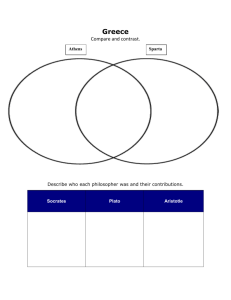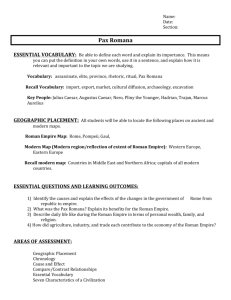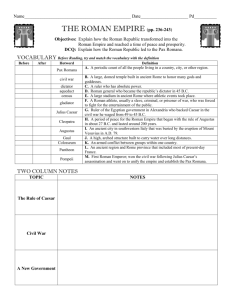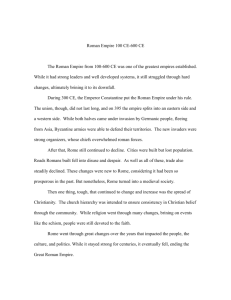Chapter 15 - Sugarcreek Local Schools
advertisement
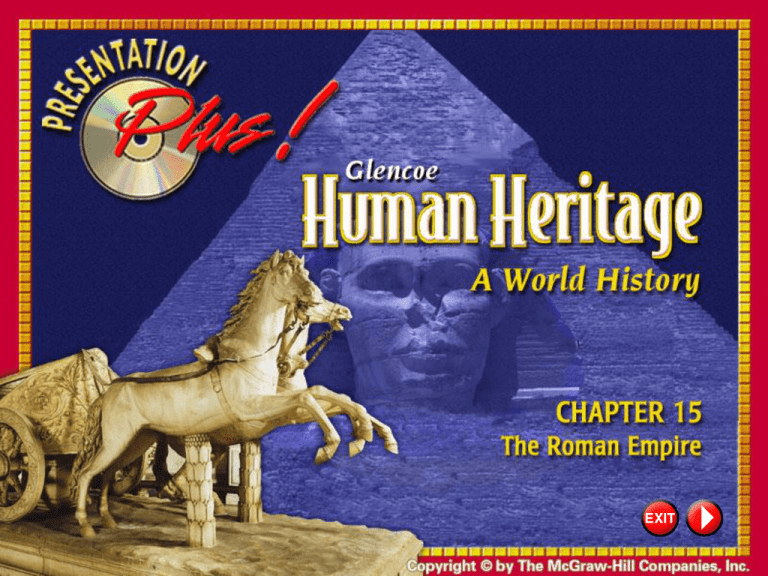
CHAPTER FOCUS SECTION 1 The Rule of Augustus SECTION 2 Pax Romana SECTION 3 Daily Life SECTION 4 Fall of the Empire CHAPTER SUMMARY & STUDY GUIDE CHAPTER ASSESSMENT 2 Click a hyperlink to go to the corresponding section. Press the ESC key at any time to exit the presentation. Overview • Chapter 15 traces the Roman Empire from the rule of Augustus to the fall of Rome. – Section 1 summarizes the rule of Augustus. – Section 2 describes Roman contributions to trade and law during the Pax Romana. – Section 3 discusses the daily life of Romans. – Section 4 analyzes the causes of the fall of the Roman Empire. 3 Click the mouse button or press the Space Bar to display the information. Objectives After studying this chapter, you will be able to: • explain how Augustus ruled the Roman Empire. • analyze what happened to trade and law during the Pax Romana. • describe daily life during the Pax Romana. • summarize why the Roman Empire declined. • discuss efforts to save the Roman Empire. 4 Click the mouse button or press the Space Bar to display the information. Read to Discover • How Augustus ruled the Roman Empire • What happened to trade and law during the Pax Romana • What daily life was like during the Pax Romana • Why the Roman Empire declined 5 Click the mouse button or press the Space Bar to display the information. The Chapter Focus is on page 233 of your textbook. Terms to Learn • emperor • census • tariffs • gladiators 6 People to Know • Augustus • Marcus Aurelius • Diocletian • Constantine I • Alaric Places to Locate • Circus Maximus • Constantinople • Adrianople • Danube River Click the mouse button or press the Space Bar to display the information. Click the Speaker On button to listen to the words. Why It’s Important In 27 B.C., Octavian told the Senate that he had restored the republic, and he offered to resign as sole ruler of Rome. The Senate turned down the offer and gave him several titles. In the end, Octavian took for himself the title of Augustus, or “revered one.” That is what he is generally called in history books. In practice, Octavian became the first Roman emperor, or absolute ruler of an empire. His policies paved the way for more than 200 years of peace. Even after the empire collapsed, Roman influence would survive in much of the world. Click the Speaker On button to replay the audio. 7 The Rule of Augustus • Augustus was a clever politician, who held the offices of consul, tribune, high priest, and senator all at the same time. • Augustus kept the assemblies and government officials of the republic, yet strengthened his authority in two ways: – For control, he had every soldier swear allegiance to him. – He built up his imperial household to take charge of the daily business of government. 9 Click the mouse button or press the Space Bar to display the information. Section 1 begins on page 233 of your textbook. The Rule of Augustus (cont.) • He gave enslaved people and freedmen, or former enslaved people, a chance to be part of the government. • Augustus pushed Rome’s borders to natural boundaries that would be easy to defend. • He gave provincial governors long terms of office and paid them large salaries. • To make sure that people did not pay too little or too much tax, Augustus ordered a census, or population count, to be taken from time to time. 10 Click the mouse button or press the Space Bar to display the information. The Rule of Augustus (cont.) • Augustus ruled for 41 years, bringing peace, patriotism, and pride to the Romans. • Most important, however, he reorganized the government of Rome so that it ran well for more than 200 years. 11 Click the mouse button or press the Space Bar to display the information. Section Assessment Why did Augustus refuse to be crowned emperor? He knew most Romans would not accept one-person rule unless it was in a republic. 12 Click the mouse button or press the Space Bar to display the answer. Section Assessment (cont.) How did Augustus try to make the Roman Empire like a republic? He kept assemblies and government officials, made senators feel honored, talked of tradition and the need to bring back “old Roman virtues,” and made the official religion important again. 13 Click the mouse button or press the Space Bar to display the answer. Section Assessment (cont.) Demonstrating Reasoned Judgment Which of Augustus’s improvements do you think was the most important? Explain. Answers will vary. 14 Click the mouse button or press the Space Bar to display the answer. Section Assessment (cont.) Draw the diagram found on page 234 of your textbook, and use it to show the achievements of Augustus. Augustus won the loyalty of soldiers, gave enslaved people and freedmen a chance to be part of the government, rounded out the empire to its natural frontiers, reformed provincial government, ordered a census, wrote strict laws to control public behavior, set up a fire brigade and police force, built Rome’s first library, and so on. 15 Click the mouse button or press the Space Bar to display the answer. Pax Romana • The peace that Augustus brought to Rome, called the Pax Romana, lasted for 200 years. • Rome and its people prospered, civilization spread, and cultures mixed. 17 Click the mouse button or press the Space Bar to display the information. Section 2 begins on page 234 of your textbook. Trade • With peace came increased trade as goods moved freely and safely along trade routes. • There were no tariffs, or taxes placed on goods brought into the country. • Shipping became a big business, and increased trade meant more business for Romans. 18 Click the mouse button or press the Space Bar to display the information. Law • During the Pax Romana, Roman law went through major changes. • In writing new laws that would be fair to non-Romans and Romans, Roman judges were helped by special lawyers and legal writers called juris prudentes. • Everyone was considered equal before the law and innocent until proven guilty. • By about 125 A.D., Roman law was standardized, making legal procedures the same in all parts of the empire. 19 Click the mouse button or press the Space Bar to display the information. Section Assessment What happened to trade during the Pax Romana? Trade increased. 20 Click the mouse button or press the Space Bar to display the answer. Section Assessment (cont.) What happened to law during the Pax Romana? Certain principles of fairness were developed, including the idea that everyone is equal before the law and that a person is considered innocent until proven guilty. By about 125 A.D. the law was standardized. 21 Click the mouse button or press the Space Bar to display the answer. Section Assessment (cont.) Evaluating Information Do you think the term Pax Romana was a good term for this 200-year period in Roman history, or would you explain it with another term? Explain. Answer will vary but it can be noted that it was a time of Roman prosperity, few battles took place, civilization spread, and cultures mixed. 22 Click the mouse button or press the Space Bar to display the answer. Section Assessment (cont.) Draw the diagram on page 236 of your textbook, and use it to show the effects of Pax Romana. Effects of Pax Romana were that Rome prospered, cultures mixed, trade increased, pirates cleared from the Mediterranean, shipping became big business, Roman businesses grew, new laws were written and old ones revised, laws became standardized, and so on. 23 Click the mouse button or press the Space Bar to display the answer. Daily Life • In the early years of the empire, about 1 million people lived in Rome. • A rich person in Rome lived in a domus, or house, with marble walls, colored stone floors, and windows made of small panes of glass, furnace heating, and running water. • Most Romans, however, were not rich. • They lived in high-rent apartment houses called islands that were six or more stories high. 25 Click the mouse button or press the Space Bar to display the information. Section 3 begins on page 236 of your textbook. The Family • In Rome, the family was all-important. • The father was head of the household; his word was law. • After the age of 12, the sons of poor families went to work, while the sons of rich families began their formal education. • After the age of 12, the daughters of the rich were given private lessons at home. • Wealthy women had enslaved people to do their housework to free themselves to study the arts, literature, and fashions. 26 Click the mouse button or press the Space Bar to display the information. At Leisure • The Romans enjoyed dice gambling and public bathhouses. • Under the empire, the government staged free public games, including circuses, chariot races, and gladiatorial games. • The people who fought animals and one another in arenas were called gladiators. • A few gladiators won their freedom, but those that gave a poor performance were killed, even if they survived the fight. 27 Click the mouse button or press the Space Bar to display the information. Section Assessment What kind of schooling did Roman children receive? Until age 12, boys and girls went to school. Wealthy males continued their studies while girls did not. Wealthy females might have been taught at home. 28 Click the mouse button or press the Space Bar to display the answer. Section Assessment (cont.) What did the Romans do for entertainment? They gambled with dice, met at public bathhouses, and watched public games. 29 Click the mouse button or press the Space Bar to display the answer. Section Assessment (cont.) Drawing Conclusions What conclusions can you draw about Roman society based upon popular leisure activities? Answers will vary. 30 Click the mouse button or press the Space Bar to display the answer. Section Assessment (cont.) Draw the diagram found on page 240 of your textbook, and use it to compare family life in the United States with family life during the Pax Romana. Diagrams will vary. 31 Click the mouse button or press the Space Bar to display the answer. Fall of the Empire • The Pax Romana ended after about 200 years, conditions in the Roman Empire grew worse, and by 476 A.D., there was no empire left. • Politically, the Roman Empire fell because the emperors had no written rule about who was to inherit the throne upon an emperor’s death. • In 161 A.D., Marcus Aurelius became a kind, intelligent, and devoted emperor. 33 Click the mouse button or press the Space Bar to display the information. Section 4 begins on page 240 of your textbook. Fall of the Empire (cont.) • Aurelius’s son, Commodus, became emperor when Marcus Aurelius died in 180 A.D. • He was so cruel and hated that in 192 A.D. he was strangled and the throne was sold to the highest bidder. • For nearly 100 years, legion fought legion to put its own emperor on the throne. • Economically, the Roman Empire fell because the emperor raised taxes in order to pay his soldiers high wages to keep them happy and supportive. 34 Click the mouse button or press the Space Bar to display the information. Fall of the Empire (cont.) • The Romans began to suffer from inflation, or a period of ever-increasing prices. • Many people began to barter, or exchange goods without using money. • Thirdly, Rome fell because foreign enemies, Germanic hunters and herders from northern and central Europe, began to raid Greece and Gaul. 35 Click the mouse button or press the Space Bar to display the information. Diocletian and Constantine I • Two emperors, Diocletian and Constantine I, tried very hard to save the Roman Empire from collapse. • Diocletian, who ruled from 284 to 305 A.D., fortified the frontiers and reorganized the governments. • Also, Diocletian established the official policy of rule by divine right and divided the Roman Empire into two parts. 36 Click the mouse button or press the Space Bar to display the information. Diocletian and Constantine I (cont.) • In 312 A.D., Constantine I became emperor and ruled until 337 A.D. • Constantine took even firmer control than Diocletian. • Despite the changes made by Diocletian and Constantine, the Roman Empire continued to decline in the west. • In 330 A.D., Constantine moved the capital from a dying Rome east to the newly built city of Constantinople in present-day Turkey. 37 Click the mouse button or press the Space Bar to display the information. End of the Empire • Neither Diocletian nor Constantine I succeeded to save the Roman Empire. • In 378 A.D., a Germanic group defeated Roman legions at the Battle of Adrianople. • In 410 A.D., the Germanic chief Alaric and his soldiers invaded Rome, burning records and looting the treasury. • The Roman Senate told the people, “You can no longer rely on Rome for finance or direction. You are on your own.” 38 Click the mouse button or press the Space Bar to display the information. Section Assessment How did wealthy landowners react to economic reforms by Diocletian and Constantine? They opposed the economic reforms or tried to escape them. 39 Click the mouse button or press the Space Bar to display the answer. Section Assessment (cont.) How did Germans gain control of the Roman Empire? They defeated Roman legions at the battle of Adrianople with the help of iron stirrups, crossed the frozen Rhine River and entered Gaul, and invaded Rome. 40 Click the mouse button or press the Space Bar to display the answer. Section Assessment (cont.) Identifying Alternatives What do you think could have been done by either Diocletian or Constantine to save the Roman Empire? Answers will vary. 41 Click the mouse button or press the Space Bar to display the answer. Section Assessment (cont.) Draw the diagram on page 244 of your textbook, and use it to summarize the causes for the fall of the Roman Empire. political–no written rules on inheriting the throne, influence of the Praetorian Guard economic–high taxes to buy loyalty of soldiers, inflation, gold shortages, and declining value of money foreign–frontiers left open to invaders, attacks from German hunters and herders, pressure from the Huns 42 Click the mouse button or press the Space Bar to display the answer. Chapter Summary & Study Guide • Octavian, better known as Augustus, became the first Roman emperor in 27 B.C. • Reorganization of the empire by Augustus introduced a 200-year period of peace, called the Pax Romana. • During the Pax Romana, trade increased, and Roman law became standardized. • During the Pax Romana, about one million people lived in Rome, where they suffered from such problems as overcrowding, pollution, crime, and unemployment. 44 Click the mouse button or press the Space Bar to display the information. Chapter Summary & Study Guide (cont.) • Whether rich or poor, most Roman children went to school until age 12. • The Roman government staged free public games to entertain the people. • Reasons for the fall of Rome include the lack of a formal rule for inheriting the throne, inflation, and attacks by Germanic invaders. • Despite efforts by Diocletian and Constantine I to save the empire, Rome fell to Germanic invaders in 410 A.D. 45 Click the mouse button or press the Space Bar to display the information. Understanding the Main Idea How did Augustus make life safer for people living in Rome? He made it safer by setting up a fire brigade and police force. 47 Click the mouse button or press the Space Bar to display the answer. Understanding the Main Idea How did increased trade during the Pax Romana affect the Romans? It brought more business and wealth, turning Italy into a manufacturing center. 48 Click the mouse button or press the Space Bar to display the answer. Understanding the Main Idea Why did the Romans change the laws set down in the Twelve Tables? They changed the laws because the times were different and the old laws did not apply to conquered territories. 49 Click the mouse button or press the Space Bar to display the answer. Understanding the Main Idea Why was it important to make Roman law standardized across the empire? Making the law standard across the empire helped govern a large area. 50 Click the mouse button or press the Space Bar to display the answer. Understanding the Main Idea What happened to some animal species as a result of the public games? They were eventually wiped out. 51 Click the mouse button or press the Space Bar to display the answer. Understanding the Main Idea How did the Praetorian Guard contribute to the empire’s decline? They weakened Rome by murdering the emperor and selling the throne. 52 Click the mouse button or press the Space Bar to display the answer. Understanding the Main Idea Why did Diocletian divide the Roman Empire in two? The Roman Empire was too big for one person to rule well. 53 Click the mouse button or press the Space Bar to display the answer. Understanding the Main Idea What were the main reasons for the fall of the Roman Empire? The main reasons were the absence of a written rule for inheriting the throne, high taxes and inflation, and the Germanic invasions. 54 Click the mouse button or press the Space Bar to display the answer. Critical Thinking What were Augustus’s strengths and weaknesses as a ruler? Answers will vary. 55 Click the mouse button or press the Space Bar to display the answer. Critical Thinking Why would the absence of tariffs increase trade? Answers will vary. Without tariffs, the prices of goods are lower. 56 Click the mouse button or press the Space Bar to display the answer. Critical Thinking Would you have enjoyed living in Rome during the Pax Romana? Explain your answer. Answers will vary. 57 Click the mouse button or press the Space Bar to display the answer. Critical Thinking What happens to a government if it does not have rules for passing on power from leader to leader? Answers will vary. 58 Click the mouse button or press the Space Bar to display the answer. Geography in History Location Refer to the map on page 235 of your textbook. Describe the general location of the Roman Empire according to its longitude and latitude. Also identify the location of the imaginary dividing line between the Western and Eastern Empires. The empire stretched from about 10º W to 45º E longitude, and north and south from 25º N to 40º N latitude. The division between empires approximately paralleled 20º E longitude. 59 Click the mouse button or press the Space Bar to display the answer. The Roman Empire’s employment office has published a list of job openings, and all people are invited to apply. During the rule of which later Roman emperor, Marcus Aurelius or Diocletian, might this have occurred? 60 Explore online information about the topics introduced in this chapter. Click on the Connect button to launch your browser and go to the Human Heritage: A World History Web site. At this site, you will find interactive activities, current events information, and Web sites correlated with the chapters and units in the textbook. When you finish exploring, exit the browser program to return to this presentation. If you experience difficulty connecting to the Web site, manually launch your Web browser and go to http://www.humanheritage.glencoe.com 62 330 A.D. 27 B.C. Octavian becomes first Roman emperor 63 Constantine I moves Roman capital to Constantinople 410 A.D. Rome falls to Germanic invaders 125 A.D. 378 A.D. Roman law is standardized Battle of Adrianople Click the mouse button or press the Space Bar to display the information. Diocletian 245 A.D.-313 A.D. Roman Emperor Diocletian was born of humble parents in what is now Croatia, an area in eastern Europe ruled by the Romans. He rose to power as an officer in the Roman army, and it was his troops who proclaimed him emperor in 284 B.C. Diocletian’s division of the empire into parts earned him the loyalty of powerful supporters such as Constantine I. In 305 A.D., he retired to a castle in present-day Split, Croatia. 64 The Atrium Many shopping malls today have an atrium, a sky-lit central court. The idea for the atrium comes from ancient Rome. In a Roman house, the atrium was the central room. It was often open to the sky and had a pool to collect rainwater. 65 The Pantheon The “good emperor” Hadrian built the Pantheon in Rome as a temple to honor all the gods. Today the beautiful building is a national shrine, a church, and the burial place of two kings of Italy. 66 Identifying the Main Idea • As you read about world history, you come across historical dates, events, and names. • These details are easier to understand and remember when they are connected to one main idea. • Understanding the main ideas allows you to grasp the whole picture or story. • The details then become more easily understood. Continued on next slide. 67 Click the mouse button or press the Space Bar to display the information. Identifying the Main Idea Follow these steps to identify a main idea: • Before you read the material, find out the setting of the article or document: the time, the place, and who the writer is. • Read the material and ask, “What is the purpose of this information?” • Study any photographs or illustrations that accompany the material. Continued on next slide. 68 Click the mouse button or press the Space Bar to display the information. Identifying the Main Idea • Ask, “What are the most forceful statements in this material?” • Identify supporting details. • Identify the main idea, or central issue. Continued on next slide. 69 Click the mouse button or press the Space Bar to display the information. Identifying the Main Idea The passage on page 242 of your textbook comes from a document issued by Diocletian, the emperor of Rome from 284 to 305 B.C. In it, he describes a plan for ending Rome’s economic problems. Read the passage and answer the questions that follow. Continued on next slide. 70 Identifying the Main Idea Why has Diocletian issued this document? This document was issued to announce laws regulating the maximum price of goods. Continued on next slide. 71 Click the mouse button or press the Space Bar to display the answer. Identifying the Main Idea What main idea, or central issue, is discussed by the document? The central issue is widespread high prices. Continued on next slide. 72 Click the mouse button or press the Space Bar to display the answer. Identifying the Main Idea What supporting details are used to support the main idea? Supporting details include: prices stay high even in good years or time of ample supply, some greedy merchants have enough wealth to satisfy entire nations, a single purchase might rob a soldier of his bonus or salary. Continued on next slide. 73 Click the mouse button or press the Space Bar to display the answer. Identifying the Main Idea What forceful statement does Diocletian use to make sure people do not miss the seriousness of the central issue? He says, “the penalty for violating this law shall be death.” 74 Click the mouse button or press the Space Bar to display the answer. End of Custom Shows WARNING! Do Not Remove This slide is intentionally blank and is set to auto-advance to end custom shows and return to the main presentation.


